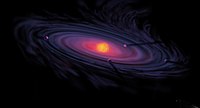
Photo from wikipedia
Heritage of oxygen isotopic heterogeneity of CO, H2O, and silicates in the early Solar System from the protosolar molecular cloud. The Sun is 16O-enriched (Δ17O = −28.4 ± 3.6‰) relative… Click to show full abstract
Heritage of oxygen isotopic heterogeneity of CO, H2O, and silicates in the early Solar System from the protosolar molecular cloud. The Sun is 16O-enriched (Δ17O = −28.4 ± 3.6‰) relative to the terrestrial planets, asteroids, and chondrules (−7‰ < Δ17O < 3‰). Ca,Al-rich inclusions (CAIs), the oldest Solar System solids, approach the Sun’s Δ17O. Ultraviolet CO self-shielding resulting in formation of 16O-rich CO and 17,18O-enriched water is the currently favored mechanism invoked to explain the observed range of Δ17O. However, the location of CO self-shielding (molecular cloud or protoplanetary disk) remains unknown. Here we show that CAIs with predominantly low (26Al/27Al)0, <5 × 10−6, exhibit a large inter-CAI range of Δ17O, from −40‰ to −5‰. In contrast, CAIs with the canonical (26Al/27Al)0 of ~5 × 10−5 from unmetamorphosed carbonaceous chondrites have a limited range of Δ17O, −24 ± 2‰. Because CAIs with low (26Al/27Al)0 are thought to have predated the canonical CAIs and formed within first 10,000–20,000 years of the Solar System evolution, these observations suggest oxygen isotopic heterogeneity in the early solar system was inherited from the protosolar molecular cloud.
Journal Title: Science Advances
Year Published: 2020
Link to full text (if available)
Share on Social Media: Sign Up to like & get
recommendations!